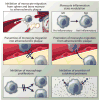Imaging and nanomedicine in inflammatory atherosclerosis
- PMID: 24898749
- PMCID: PMC4110972
- DOI: 10.1126/scitranslmed.3005101
Imaging and nanomedicine in inflammatory atherosclerosis
Abstract
Bioengineering provides unique opportunities to better understand and manage atherosclerotic disease. The field is entering a new era that merges the latest biological insights into inflammatory disease processes with targeted imaging and nanomedicine. Preclinical cardiovascular molecular imaging allows the in vivo study of targeted nanotherapeutics specifically directed toward immune system components that drive atherosclerotic plaque development and complication. The first multicenter trials highlight the potential contribution of multimodality imaging to more efficient drug development. This review describes how the integration of engineering, nanotechnology, and cardiovascular immunology may yield precision diagnostics and efficient therapeutics for atherosclerosis and its ischemic complications.
Copyright © 2014, American Association for the Advancement of Science.
Figures




References
-
- Libby P, Ridker PM, Hansson GK. Progress and challenges in translating the biology of atherosclerosis. Nature. 2011;473:317–325. - PubMed
-
- Libby P. Inflammation in atherosclerosis. Nature. 2002;420:868–874. - PubMed
-
- Mitka M. New basic care goals seek to rein in global rise in cardiovascular disease. JAMA. 2012;308:1725–1726. - PubMed
Publication types
MeSH terms
Grants and funding
LinkOut - more resources
Full Text Sources
Other Literature Sources
Medical

